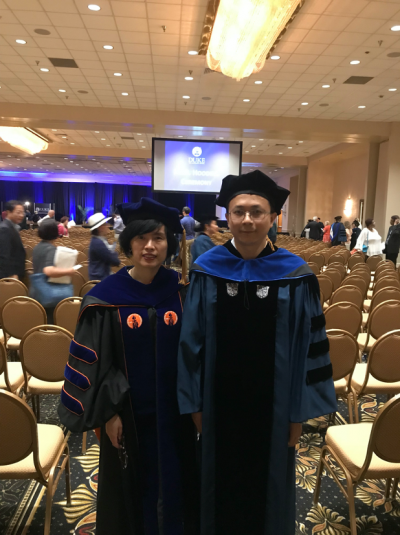
Dr. Yang Zhang’s thesis work just appeared in a paper on "Precision measurement of the neutral pion lifetime" in Science on May 1, 2020. Dr. Yang Zhang received his Ph.D. from Duke in May 2018 under the supervision of Prof. Haiyan Gao.
Strong force is one of the four fundamental forces in nature and is the force responsible for binding nucleons into atomic nuclei. The theory describing the strong force is called quantum chromodynamics (QCD) with quarks and gluons as degrees of freedom. A quark can never exist in isolation, and it always exists in the form of a hadron, a composite particle made of quarks and gluons. The lightest hadron in nature is the neutral pion, π0 particle. While QCD has been well tested by experiments at high energies where perturbative calculations can be carried out -- in the non-perturbative region -- one knows very little about how QCD works because it is notoriously difficult to solve QCD analytically. On the other hand, the π0 radiative decay width, Γ(π0→γγ) -- a quantity directly related to its lifetime -- can be predicted analytically from QCD directly. This is possible due to the explicit breaking of the axial symmetry due to quantum fluctuations, also known as the axial or chiral anomaly. Therefore precise measurements of the π0 radiative decay width will allow for a direct test of the QCD prediction and symmetry breaking by pure quantum effects.
Dr. Zhang analyzed the data from a Primakoff (PrimEx-II) experiment in Hall B at Jefferson Lab. In a Primakoff experiment, a photon beam is incident on a nuclear target, and π0 can be produced in the Coulomb field of the target nucleus, known as the Primakoff effect. In both the PrimEx-I and PrimEx-II experiments, the two photons from the π0 decay were subsequently detected in an electromagnetic calorimeter, and Γ(π0→γγ) was extracted from the measured Primakoff differential cross sections. The PrimEx-II experiment achieved a final result of Γ(π0→γγ) = 7.798 ± 0.056 (stat.) ± 0.109 (syst.) electron volt (eV). Combining this result with the earlier PrimEx-I result led to a weighted average result of 7.802 ± 0.052 (stat.) ± 0.105 (syst.) eV. This is the world’s most precise value of this quantity and confirms the prediction based on chiral anomaly in QCD. The PrimEx-I and PrimEx-II collaborations were led by Prof. Ashot Gasparian from North Carolina A&T State University. Prof. Gao and Dr. Yang Zhang joined the PrimEx-II collaboration in spring 2011. To achieve the final precision, it took Yang Zhang six years to complete the data analysis and his Ph.D. dissertation. Currently, Dr. Yang Zhang is a quantitative researcher at JPMorgan Chase & Co.
Duke Research Blog featured this news in their article "Hard-Won Answer Was Worth the Wait". Read it online here.
Photo credit: Dr. Min Huang, (Ph.D. May 2016, Duke University)